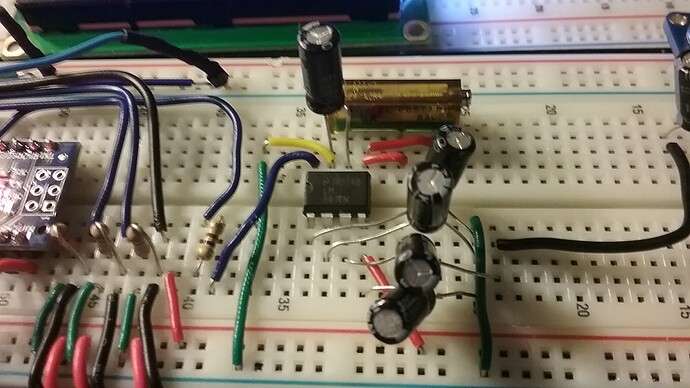This what actually i needed. i have an arduino + condenser mic which was connected to analog pin.
i need my mic to activate for a certain frequency range. i thought do this with Phase lock loop. when the pll detect my required frequency range it should lock the pll and start to read analog signal from mic and store it on a sd card. Im not quite sure whether is this possible to do. Suggest me how to do this or any IC's. My required frequency range is around 380Hz-500Hz
Can i use tone detector IC(LM567) for this purpose?
PLL should be a hardware which can externally connect to arduino mega
Can i use tone detector IC(LM567) for this purpose?
Yes all you need to do is to is to feed the tone detected or PLL lock into an input and use that to trggger sampling. With a Mega you have enough memory for about one second of audio.
So to lock the PLL mic should connected to LM567 ic input right? when the pll get locked then only sampling needed to start. Do u have any pll circuit. i dont know how to choose resistor values and Capacitor values properly
Is there anybody who has experienced on LM567? plz send me a circuit how to lock the pll around frequency range around 380HZ-480Hz?
So to lock the PLL mic should connected to LM567 ic input right?
No.
Use a PLL OR a LM567.
plz send me a circuit how to lock the pll around frequency range around 380HZ-480Hz?
A PLL or the LM567?
Read the data sheet of whatever chip you want to use LM567 or PLL.
Here inside the lm567 there's a internal pll right??? or else for trigger for certain frequency range lm567 or pll can use???? Am i correct ?
LM567/NE567 is a decoder, which if effectively the same as a specialised PLL. It switches the output when the input frequency is in range. It's all you need and it's pretty simple to use. The datasheet is helpful, you just need to work out the component values for your chosen frequency band.
Steve
I have been able to successfully decode a tone with the LM567 IC. The tone is 2400Hz but with a 5k multi turn pot and a 10uF cap for C6 you should have no trouble hitting that frequency. I used the diagram from Scary Terry.
http://www.scary-terry.com/more_stuff/tonedet/tonedet.htm
Up to this point I have been passing the tone from an output pin on a nano straight into the chip. I've tried using the Adafruit gain mic and my circuit is not recognizing the signal the same as from the nano. Possible issues could be noise, voltage or amplitude differences. If anyone has experience they would be willing to share it would be great. I'm really new to all this so I don't have an scope to compare the signal from the mic to the one from the Arduino.
@russrex
Before sending it to processor better to pass the signal through an OP_AMP IC. Because processor ADC only can pick signals between 0-5V. The negative parts of the signals being cancelled out.
refer this site
. The negative parts of the signals being cancelled out.
Don't be silly. When using an Arduino you bias the signals to 2.5V so it never sees negative voltages.
You said:-
This what actually i needed. i have an arduino + condenser mic which was connected to analog pin.
We all assumed you had done this correctly but is sounds like you haven't. You need a 10K resistor from the Analogue input to +5V, you need another from the same input to ground. Then you need to AC couple your audio signal into it. Which means connecting through a series capacitor.
The LM567 will quite happily lock onto a signal of 100 to 200mV. If you do not have that much audio signal then you have to use a transistor or op-amp to amplify it before the LM567 will lock onto it. No need to feed it through an Arduino first, that is just silly.
But doesn't a LM576 only lock on to a single frequency? This may be a problem since OP is looking for a sound that may have multiple frequency components. Depending on the number of frequency components, OP might need a LOT of these chips. It would be more efficient to do DSP filtering to do the sound detection IMHO. It would at least be more robust.
